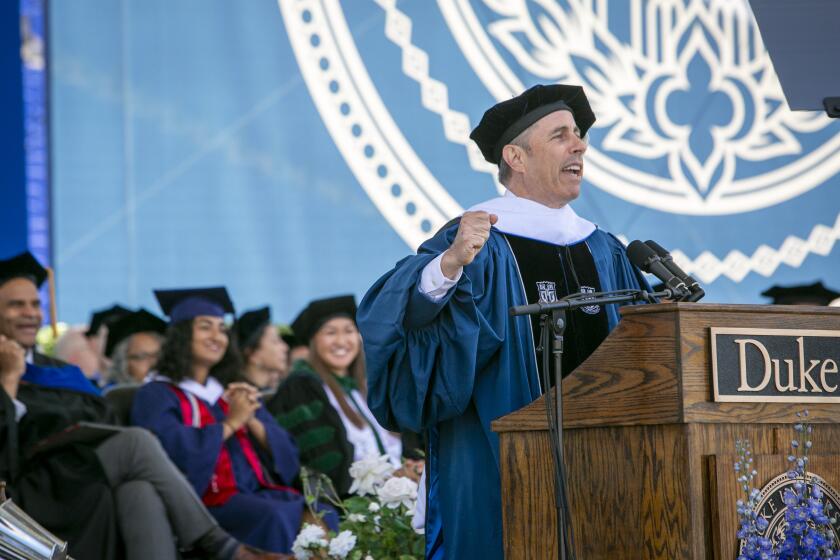Our past, in Super 8
“You,” Snowden Becker told me over the phone, “are just what we’re looking for.”
All because of my 3-inch-square yellow box that held 50 feet of 8-millimeter film shot in 1949. Film that nobody in my immediate family had ever seen. Certainly not me. And I had the strongest interest in seeing it. Because I was the subject. My mom’s handwriting on the little box of Kodachrome said: “Bobby 2 yrs.”
If Becker is right, thousands of people like me will bring little boxes like that to a couple dozen sites around America on Saturday to participate in the first National Home Movie Day. From Chicago to Pike’s Peak to Buffalo to Santa Fe, volunteer film archivists, armed with a variety of projectors, will screen your home movies -- movies often shoved deep into garages and basements as projectors broke and the marvel of videotape muscled aside film.
The Southern California screening site is the Japanese American National Museum, at 369 E. 1st St., open from 10 a.m. to 5 p.m. It was chosen because the museum has compiled a collection of home movies of the Japanese American community, including some footage shot surreptitiously inside World War II internment camps.
The notion of Home Movie Day was born over beers in Boston in November at a conference of the Assn. of Moving Image Archivists -- people whose newsletter reports things like Sweden’s plan to restore aging film of former U.N. Secretary-General Dag Hammarskjold. Becker, herself a trained film archivist, was deeply worried about all that home-movie film hidden or disregarded. What we need, she and a few of her contemporaries decided, is a consciousness-raising effort: a day when people would be invited to root out their long-ignored home movies, watch them, appreciate them and vow to preserve them.
It was at that moment in my conversation with Becker that I remembered the little yellow box. My mom had given it to me two or three years ago. I didn’t have a projector -- as best I can remember, my parents never had one, either -- so I’d vowed to get the film converted to video, but never did. Then, two months ago, my mom died and I had one more thing to feel guilty about. Now it hit me: She was probably on the film. It would be a way of reconnecting.
I didn’t want to wait for Home Movie Day. I wanted to see Mom now. Becker was kind enough to invite me to USC’s Moving Image Archives, where she spends her Fridays as a volunteer. She makes a living as an editor for interactive programs at the Getty, but her passion is using film as a historical document. Like many organizers of Home Movie Day, she is in her 30s, born after the crest of the home-movie experience, possessing a romantic curiosity about it, convinced there are social insights in watching an unknown family’s Mexican vacation.
People who come out Saturday to screen their movies of the ‘40s, ‘50s and ‘60s “will remember the clothes, the way people wore their hair,” she said. “It’s how the American memory is being preserved
Becker had known my film was 8-millimeter color from the way I described the yellow box. Most home movies were shot on one of three formats: 8 millimeter, Super 8 or 16 millimeter. (There is even a small cult that tries to preserve works shot on European-made 9.5-millimeter stock.) In USC’s basement archives, she spooled a bit of film from the little reel and saw images. But when she tested the film on some of the old editing viewers, none of them worked or were compatible with 8 millimeter. Which meant I was going to have to wait. But I couldn’t.
So at Becker’s suggestion, I called Alan Stark at Film Technology Co. in Hollywood, which is going to provide equipment and volunteer help at Saturday’s event, and he transferred the film to a DVD.
I took the DVD home and put it on, and in that soundless world of fuzzy images it became clear to me what a half-century-old piece of film gives you that videotape cannot.
I watched a chubby-cheeked 2-year-old in front of a cake, apparently at his birthday party, apparently on birthday-party sensory overload, alternately smiling and crying, occasionally flailing his arms. (“Some things never change,” my wife said as she walked by.) With no sound, the images seemed to suck more concentration from me. Or maybe it was the hazy quality of the picture.
And then my dad, dead 13 years this month, stuck his head in from the side. He had hair! Of course, I realized, he was only 32. I’d seen him at this age in photos, but never as a moving presence. And unlike my later memories that wiped so many good times away, he didn’t have Alzheimer’s. He was smiling, and coaxing a smile out of the boy.
There were other ghosts: Uncle Sam, and my grandmother’s second husband. And there were others who still live, aunts Ida and Edith, so vibrant. Their kids -- my four older cousins -- were playing with the little boy. One of the cousins was rocking on what I took to be one of the boy’s presents, a spring-propelled bucking bronco. It was Andi, age 7. Wait a minute. Didn’t I just go to Andi’s 60th birthday party? How did that happen?
The camera panned the adults in the room, and they spoke silently to it with respectful smiles, without any of the self-consciousness or coolness that we reserve for the all-too-ubiquitous video camera.
Only two things eluded me: Who was behind the camera, and where was Mom? I kicked myself again for not doing this sooner. And then some bursts of light signaled the end of the reel. Three minutes, 32 seconds. A rushed, incomplete but thrilling trip back through time.
Dwight Swanson, a Maine social historian who works at a nonprofit historic film archive and is coordinating Home Movie Day in Portland, said he is fascinated by the rituals that accompanied watching such films in the pre-video era. “I ask people how they watched them. It was definitely a family thing. Often it was the father in charge of the projector ... or, every Christmas, usually once a year, the family would get together” to watch newer film, “maybe neighbors too.”
Kevin Phillips, a petroleum-company surveyor who is coordinating home movie viewing in College Station, Texas, said part of the event is to “demonstrate the lasting value of film. With a lot of the technologies we have, there’s a gee-whiz factor, but it hasn’t been proved to have a lasting quality to it, whereas film has been around now for over 100 years; there are movies in existence from the 1890s.
“I remember in the early ‘80s, when people were switching to videotape, people would have home movies transferred to video and then throw the film away -- and that’s a great tragedy. One of the points of Home Movie Day is to get people to hold onto their film because that will probably outlast videotape.” The storage life of DVDs remains to be seen, experts say.
At home, I watched my DVD-converted 50 feet of film again and again, trying to soak in what it said about technology, history, family. I wished I had another reel. But I knew I’d been lucky simply to have this. I thought about what Swanson in Maine had said about another purpose of Saturday’s sessions: “Because people aren’t dealing with film anymore, it’s become a slightly mysterious object, and we wanted to demystify that.”
Funny. To me, it feels more mysterious now.
More to Read
Only good movies
Get the Indie Focus newsletter, Mark Olsen's weekly guide to the world of cinema.
You may occasionally receive promotional content from the Los Angeles Times.






